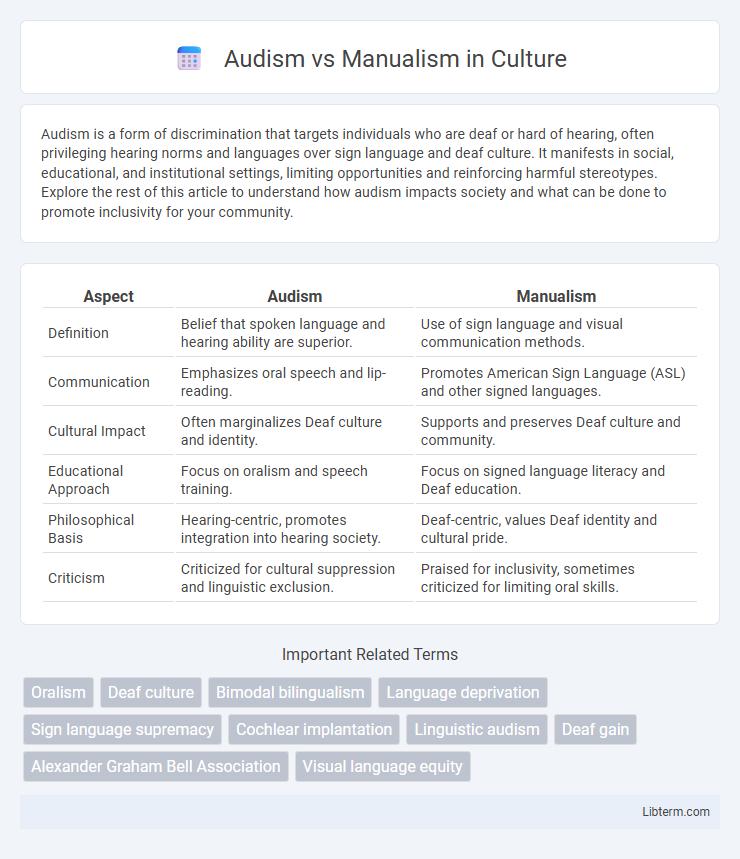Audism is a form of discrimination that targets individuals who are deaf or hard of hearing, often privileging hearing norms and languages over sign language and deaf culture. It manifests in social, educational, and institutional settings, limiting opportunities and reinforcing harmful stereotypes. Explore the rest of this article to understand how audism impacts society and what can be done to promote inclusivity for your community.
Table of Comparison
| Aspect | Audism | Manualism |
|---|---|---|
| Definition | Belief that spoken language and hearing ability are superior. | Use of sign language and visual communication methods. |
| Communication | Emphasizes oral speech and lip-reading. | Promotes American Sign Language (ASL) and other signed languages. |
| Cultural Impact | Often marginalizes Deaf culture and identity. | Supports and preserves Deaf culture and community. |
| Educational Approach | Focus on oralism and speech training. | Focus on signed language literacy and Deaf education. |
| Philosophical Basis | Hearing-centric, promotes integration into hearing society. | Deaf-centric, values Deaf identity and cultural pride. |
| Criticism | Criticized for cultural suppression and linguistic exclusion. | Praised for inclusivity, sometimes criticized for limiting oral skills. |
Understanding Audism: Definition and Impact
Audism refers to the belief that hearing ability is superior to deafness, often leading to discrimination against Deaf individuals and the devaluation of Deaf culture and sign language. This belief system impacts educational approaches by prioritizing oralism, which emphasizes speech and lip-reading, and often undermines manualism, the use of sign language as the primary mode of communication. Understanding audism is crucial for promoting equitable Deaf education and recognizing the legitimacy and richness of Deaf culture and sign languages.
Manualism Explained: History and Principles
Manualism, a communication method using sign language, originated in the early 19th century with pioneers like Laurent Clerc and Thomas Hopkins Gallaudet, who established American Sign Language (ASL) based on French Sign Language. Its core principle emphasizes visual-manual modality to facilitate natural language acquisition and cognitive development among deaf individuals, contrasting with oralist approaches that prioritize speech and lip-reading. Manualism advocates assert that sign language fosters inclusive education, cultural identity, and better linguistic outcomes compared to Audism, the belief in spoken language superiority.
Origins of Audism in Deaf Education
Audism originated in the early 19th century as an educational philosophy that prioritized spoken language and oral communication over sign language in Deaf education, often marginalizing Deaf culture. This approach was institutionalized through oralist schools, which rejected manualism--the use of sign language--and aimed to assimilate Deaf individuals into hearing society. The bias against sign language in favor of speech led to widespread suppression of natural Deaf communication methods and contributed to cultural injustices within Deaf communities.
Manualism’s Role in Deaf Culture
Manualism plays a vital role in Deaf culture by promoting the use of sign language as a primary mode of communication, reinforcing cultural identity and community cohesion. It counters audism by valuing visual language over spoken speech, empowering Deaf individuals to express themselves fully and preserving rich linguistic traditions. Emphasizing manualism supports Deaf education models that prioritize natural language acquisition and cultural affirmation.
Audism in Modern Society: Subtle and Overt Forms
Audism in modern society manifests through both subtle and overt forms, including discriminatory language, exclusion from communication in predominantly hearing environments, and biased attitudes towards deaf individuals' abilities. This systemic prejudice often undermines the value of Deaf culture and manualism, which prioritizes sign language as a primary mode of communication. Recognizing and addressing audism requires awareness of these nuanced behaviors and promoting inclusive policies that respect Deaf identity and sign language use.
Sign Language Advocacy vs Oralism
Audism promotes oralism, emphasizing speech and lip-reading, often marginalizing Deaf culture and sign language use. Manualism advocates for sign language as a primary communication mode, supporting Deaf identity and accessibility. Sign language advocacy fosters inclusivity, cognitive development, and cultural preservation, contrasting with oralism's speech-only approach.
The Debate: Audism vs Manualism in Schools
The debate between Audism and Manualism in schools centers on the prioritization of spoken language versus sign language for Deaf education. Audism promotes the use of spoken language and hearing technologies to integrate Deaf students into hearing society, while Manualism advocates for the use of American Sign Language (ASL) or other sign languages to support Deaf culture and accessible communication. This conflict influences educational policies, teaching methods, and the social inclusion of Deaf students within academic settings.
Empowerment through Manualism
Empowerment through manualism centers on the use of sign language to foster inclusive communication and cultural identity within the Deaf community, countering the marginalization often perpetuated by audism--the belief in the superiority of spoken language. Manualism supports cognitive development and social integration by providing accessible language acquisition from early childhood, enhancing educational outcomes and self-advocacy skills. Emphasizing sign language enriches Deaf empowerment by validating Deaf culture and promoting equal opportunities in education, employment, and social participation.
Challenging Audist Attitudes: Strategies for Change
Challenging audist attitudes involves promoting manualism as a legitimate and valuable form of communication within the Deaf community, emphasizing the cultural and linguistic richness of sign language. Educational programs that foster Deaf identity and encourage bilingualism in sign and spoken languages can dismantle prejudices rooted in spoken language superiority. Advocacy for policy changes in schools and workplaces supports accessibility and inclusion, disrupting systemic audism and empowering Deaf individuals.
The Future of Deaf Education: Integration or Division?
The future of deaf education hinges on the balance between audism, the privileging of spoken language, and manualism, which emphasizes sign language as the primary mode of communication. Integrating both approaches through bilingual education models can promote linguistic accessibility and cultural identity, reducing the historical divide between Deaf and hearing communities. Advances in technology and inclusive pedagogy support a more unified framework, fostering equal opportunities and preserving Deaf culture simultaneously.
Audism Infographic

 libterm.com
libterm.com